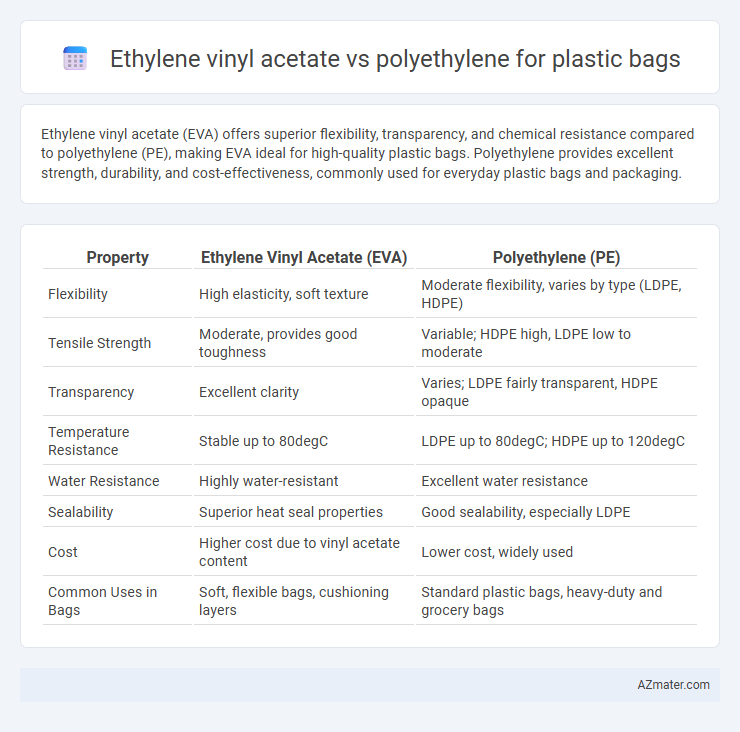Ethylene vinyl acetate (EVA) offers superior flexibility, transparency, and chemical resistance compared to polyethylene (PE), making EVA ideal for high-quality plastic bags. Polyethylene provides excellent strength, durability, and cost-effectiveness, commonly used for everyday plastic bags and packaging.
Table of Comparison
| Property | Ethylene Vinyl Acetate (EVA) | Polyethylene (PE) |
|---|---|---|
| Flexibility | High elasticity, soft texture | Moderate flexibility, varies by type (LDPE, HDPE) |
| Tensile Strength | Moderate, provides good toughness | Variable; HDPE high, LDPE low to moderate |
| Transparency | Excellent clarity | Varies; LDPE fairly transparent, HDPE opaque |
| Temperature Resistance | Stable up to 80degC | LDPE up to 80degC; HDPE up to 120degC |
| Water Resistance | Highly water-resistant | Excellent water resistance |
| Sealability | Superior heat seal properties | Good sealability, especially LDPE |
| Cost | Higher cost due to vinyl acetate content | Lower cost, widely used |
| Common Uses in Bags | Soft, flexible bags, cushioning layers | Standard plastic bags, heavy-duty and grocery bags |
Introduction to Plastic Bag Materials
Ethylene vinyl acetate (EVA) and polyethylene (PE) are two prominent materials used in plastic bag manufacturing, each offering distinct properties. EVA provides enhanced flexibility, clarity, and toughness, making it suitable for premium packaging that requires durability and aesthetic appeal. Polyethylene, available in low-density (LDPE) and high-density (HDPE) forms, is widely favored for its excellent moisture resistance, cost-effectiveness, and recyclability, serving as the standard choice for everyday plastic bags.
What is Ethylene Vinyl Acetate (EVA)?
Ethylene Vinyl Acetate (EVA) is a copolymer composed of ethylene and vinyl acetate units, known for its flexibility, clarity, and toughness. EVA offers superior elasticity and impact resistance compared to Polyethylene, making it ideal for plastic bags that require durability and stretchability. Its excellent sealing properties and resistance to cracking enhance the performance of packaging applications compared to conventional polyethylene bags.
What is Polyethylene (PE)?
Polyethylene (PE) is a widely used thermoplastic polymer known for its durability, flexibility, and chemical resistance, making it a popular choice for manufacturing plastic bags. It is available in various densities such as low-density polyethylene (LDPE) and high-density polyethylene (HDPE), each offering different tensile strength and barrier properties. Polyethylene's lightweight nature and moisture resistance contribute to its extensive use in packaging applications compared to Ethylene vinyl acetate (EVA), which offers more elasticity but lower tensile strength.
Chemical Structure Comparison: EVA vs PE
Ethylene vinyl acetate (EVA) consists of vinyl acetate copolymerized with ethylene, introducing polar acetate groups that enhance flexibility and adhesion, whereas polyethylene (PE) is a long-chain hydrocarbon polymer composed solely of repeating ethylene units with a non-polar, saturated backbone. The presence of vinyl acetate units in EVA disrupts crystallinity compared to the highly crystalline structure of PE, resulting in varied mechanical and barrier properties crucial for plastic bag applications. This chemical structure difference impacts factors such as tensile strength, elongation, and resistance to environmental stress cracking, making EVA more suitable for flexible, impact-resistant bags while PE offers superior moisture barrier performance.
Physical Properties: Strength, Flexibility, and Clarity
Ethylene vinyl acetate (EVA) offers superior flexibility and impact resistance compared to polyethylene (PE), making it ideal for applications requiring stretch and durability. EVA exhibits higher clarity and gloss, enhancing the visual appeal of plastic bags, whereas polyethylene typically has a more opaque and matte finish. In terms of strength, polyethylene generally provides better tensile strength and puncture resistance, suitable for heavy-duty carrying needs.
Cost Analysis: EVA vs Polyethylene
Ethylene vinyl acetate (EVA) typically incurs higher raw material costs compared to polyethylene (PE) due to its specialized copolymer composition, which increases production expenses. Polyethylene, especially low-density polyethylene (LDPE), remains the most cost-effective choice for plastic bag manufacturing because of its abundant availability and efficient processing techniques. Producers must weigh EVA's superior flexibility and clarity against polyethylene's economic advantages when conducting cost analysis for packaging solutions.
Environmental Impact and Recyclability
Ethylene vinyl acetate (EVA) and polyethylene (PE) differ significantly in environmental impact and recyclability; EVA contains vinyl acetate units that can hinder recycling streams and typically decomposes slower in landfill conditions compared to polyethylene. Polyethylene, especially low-density polyethylene (LDPE), is widely recycled and more readily broken down by microbial activity, reducing its long-term environmental footprint. The inclusion of EVA in plastic bags often complicates material recovery and sorting, leading to lower recycling rates and potential contamination in polyethylene recycling facilities.
Common Applications in Plastic Bags
Ethylene vinyl acetate (EVA) is commonly used in plastic bags requiring flexibility, transparency, and toughness, such as food packaging and retail shopping bags due to its excellent stress-crack resistance and clarity. Polyethylene (PE), particularly low-density polyethylene (LDPE) and high-density polyethylene (HDPE), dominates plastic bag production for grocery bags, trash liners, and packaging films because of its cost-effectiveness, moisture resistance, and strength. The choice between EVA and PE depends on specific application needs like durability, elasticity, and environmental exposure.
Performance in Packaging: Barrier Properties and Durability
Ethylene vinyl acetate (EVA) offers superior flexibility and impact resistance compared to polyethylene (PE), enhancing durability in plastic bag applications. EVA exhibits improved oxygen and moisture barrier properties, making it more effective for packaging sensitive products requiring extended shelf life. Polyethylene, while cost-effective, generally provides lower barrier protection and less elasticity, limiting its performance in high-demand packaging scenarios.
Choosing the Right Material: EVA or Polyethylene for Your Needs
Ethylene vinyl acetate (EVA) offers superior flexibility, clarity, and impact resistance compared to polyethylene, making it ideal for applications requiring durability and aesthetic appeal. Polyethylene, particularly low-density polyethylene (LDPE), provides excellent moisture barrier properties and cost-effectiveness, suitable for general-purpose plastic bags and high-volume packaging. Selecting between EVA and polyethylene depends on the balance of performance needs such as transparency, strength, and environmental conditions in your specific use case.

Infographic: Ethylene vinyl acetate vs Polyethylene for Plastic Bag
 azmater.com
azmater.com